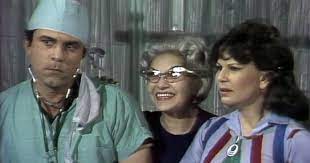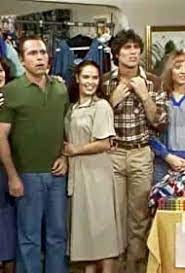¿QUÉ PASA, EE.UU.? LA PRIMERA COMEDIA BILINGÜE DE ESTADOS UNIDOS. FOTOS/VÍDEOS.
El programa de Televisión ¿Qué Pasa, USA? fue la primera comedia de situación bilingüe de Estados Unidos y la primera comedia de situación producida para PBS. Fue producido y grabado entre 1977 y 1980 frente a una audiencia de estudio en vivo en la estación miembro de PBS WPBT en Miami, Florida, y se transmitió en las estaciones miembros de PBS en todo el país.
El programa exploró las pruebas y tribulaciones que enfrentan los Peña, una familia cubanoamericana que vive en el barrio de La Pequeña Habana de Miami, mientras luchaban por hacer frente a un nuevo país y un nuevo idioma. La serie es elogiada por ser muy fiel a la vida y con precisión, aunque divertida, al retratar la vida y la cultura de la población cubanoamericana de Miami. Hoy en día, el espectáculo es apreciado por muchos miamenses como una representación verdadera, aunque humorística, de la vida y la cultura en Miami.
SINOPSIS
La serie se centró en la crisis de identidad de los miembros de la familia, ya que fueron empujados en una dirección por sus mayores, que querían mantener los valores y tradiciones cubanos, y empujados en otras direcciones por las presiones de vivir en una sociedad predominantemente angloamericana. Esto provocó muchas desventuras para toda la familia Peña, ya que se ven arrastrados en todas direcciones en su intento por preservar su herencia.
 VIDEOS- Que Pasa U.S.A.? (No. 1)..
VIDEOS- Que Pasa U.S.A.? (No. 1)..
La serie era bilingüe, reflejando el cambio de código del uso del español en el hogar y el inglés en el supermercado (“Spanglish”) predominante en los hogares cubanoamericanos en la generación posterior al éxodo cubano de la década de 1960. El uso del lenguaje en el programa fue paralelo a las diferencias generacionales en muchas familias cubanoamericanas de la época.
Los abuelos hablaban casi exclusivamente español y se mostraban reacios —a veces, incluso hostiles— a la idea de aprender inglés; un episodio presentaba una secuencia de sueños en la que Joe, el hijo de la familia, sueña con que sus abuelos hablan exclusivamente inglés (mientras que Joe y Carmen solo podían hablar español). La lucha de los abuelos con el inglés a menudo resultó en malentendidos y malapropismos humorísticos. La relativa fluidez en inglés de los padres estaba mezclada con un fuerte acento cubano y alternaban entre los dos idiomas según la situación. Los niños, que habían estado expuestos a la cultura estadounidense durante años, hablaban principalmente en inglés coloquial con un ligero acento, pero podían conversar en español de manera relativamente competente según era necesario (como cuando hablaban con sus abuelos); sin embargo, uno de los chistes recurrentes del programa giraba en torno a su matanza ocasional de la gramática o el vocabulario en español.
PERSONAJES PRINCIPALES:
* Manolo Villaverde como Pepe Peña, la figura patriarcal de la familia Peña
* Ana Margarita Martínez-Casado como Juana Peña — la figura matriarcal del hogar
* Luis Oquendo como Antonio: el padre de Juana y el principal arquetipo de abuelo nacido en Cuba para Joe y Carmen. Como era típico de los exiliados cubanos adultos que viven en Miami, Antonio no puede hablar inglés con fluidez y confía en que su hija y su yerno sean traductores del inglés al español.
* Velia Martínez como Adela: la madre de Juana y el principal arquetipo de abuela nacida en Cuba para Joe y Carmen. Al igual que su esposo Antonio, habla español con total fluidez y depende de su hija y yerno para traducir. Esto crea una dinámica que se explora extensamente en el cuarto episodio, apropiadamente titulado “We Speak Spanish” cuando comenta sobre la competencia de su hija en inglés.
* Steven Bauer (acreditado como Rocky Echevarría) como Joe Peña, el hijo arquetípico cubano-estadounidense de primera generación de Pepe y Juana; permanece hasta el episodio 28.
* Ana Margo (acreditada como Ana Margarita Menéndez) como Carmen Peña, la hija arquetípica cubana-estadounidense de primera generación de Pepe y Juana.
Otros personajes fueron: Connie Ramírez como Violeta; Barbara Ann Martin como Sharon; Glenda Díaz Rigau como Tanto Marta; Jody Wilson como la señora Allen
Bernardo Pascual como el primo Ignacio (Iggy) Peña, un papel recurrente en la cuarta y última temporada.
INVITADO COMIENZA
Andy García, Jeff Coopwood, Norma Zúñiga, Chamaco García, Patricia Jiménez-Rojo.
ESCRITORES
Luis Santeiro
Julio Vera
DIRECTORES
Bernardo lechowick
Errol falcon
La serie se emitió inicialmente durante cuatro temporadas desde 1977 hasta 1980 (se produjeron 39 episodios) y continúa funcionando en sindicación.

*LOS QUE OLVIDAN SU HISTORIA ESTAN CONDENADOS A REPETIRLA*
* THOSE WHO FORGET THEIR HISTORY ARE CONDEMNED TO REPEAT IT *
¿QUE PASA, USA? AMERICA’S FIRST BILINGUAL SITUATION COMEDY. PHOTO/VIDEOS.
The Television program ¿Qué Pasa, USA? (Spanish: What’s Happening, USA?) was America’s first bilingual situation comedy, and the first sitcom to be produced for PBS. It was produced and taped from 1977 to 1980 in front of a live studio audience at PBS member station WPBT in Miami, Florida, and aired on PBS member stations nationwide.
The program explored the trials and tribulations faced by the Peñas, a Cuban-American family living in Miami’s Little Havana neighborhood, as they struggled to cope with a new country and a new language. The series is praised as being very true-to-life and accurately if humorous, portraying the life and culture of Miami’s Cuban-American population. Today, the show is cherished by many Miamians as a true, albeit humorous, representation of life and culture in Miami.
SYNOPSIS
The series focused on the identity crisis of the members of the family as they were pulled in one direction by their elders—who wanted to maintain Cuban values and traditions—and pulled in other directions by the pressures of living in predominantly Anglo-American society. This caused many misadventures for the entire Peña family as they get pulled in all directions in their attempt to preserve their heritage.
The series was bilingual, reflecting the code-switching from Spanish use in the home and English at the supermarket (“Spanglish”) predominant in Cuban-American households in the generation following the Cuban exodus of the 1960s. The use of language in the show paralleled the generational differences in many Cuban-American families of the era.
 VIDEOS- Que Pasa U.S.A.? (No. 7)…
VIDEOS- Que Pasa U.S.A.? (No. 7)…
The grandparents spoke almost exclusively Spanish and were reluctant—at times, even hostile—toward the idea of learning English; an episode featured a dream sequence where Joe, the son of the family, dreams about his grandparents exclusively speaking English (while Joe and Carmen could only speak Spanish). The grandparents’ struggle with English often resulted in humorous misunderstandings and malapropisms. The parents’ relative fluency in English was laced with strong Cuban accents and alternated between the two languages depending on the situation. The children, having been exposed to American culture for years, spoke primarily in slightly accented colloquial English, but were able to converse relatively competently in Spanish as needed (such as when speaking to their grandparents); however, one of the running gags of the show revolved around their occasional butchering of Spanish grammar or vocabulary.
MAIN CHARACTERS:
* Manolo Villaverde as Pepe Peña — the patriarchal figure of the Peña household
* Ana Margarita Martínez-Casado as Juana Peña — the matriarchal figure of the household
* Luis Oquendo as Antonio — Juana’s father and the primary Cuban-born grandfather archetype to Joe and Carmen. As was typical of adult Cuban exiles living in Miami, Antonio is unable to speak English fluently and relies on his daughter and son-in-law to be translators from English to Spanish.
* Velia Martínez as Adela — Juana’s mother and the primary Cuban-born grandmother archetype to Joe and Carmen. Like her husband Antonio, she is wholly fluent in Spanish and relies on her daughter and son-in-law to translate. This creates a dynamic that is explored extensively in the fourth episode, appropriately titled “We Speak Spanish” when she remarks on her daughter’s competency in English.
* Steven Bauer (credited as Rocky Echevarría) as Joe Peña — the first-generation Cuban-American archetypal son of Pepe and Juana; remains until the 28th episode.
* Ana Margo (credited as Ana Margarita Menéndez) as Carmen Peña — the first-generation Cuban-American archetypal daughter of Pepe and Juana.
Other characters were: Connie Ramírez as Violeta; Barbara Ann Martin as Sharon; Glenda Díaz Rigau as Tanto Marta; Jody Wilson as Mrs. Allen
Bernardo Pascual as Cousin Ignacio (Iggy) Peña, a recurring role in the fourth and final season.
GUEST STARTS
Andy García, Jeff Coopwood, Norma Zúñiga, Chamaco García, Patricia Jiménez-Rojo.
WRITERS
Luis Santeiro
Julio Vera
DIRECTORS
Bernard Lechowick
Errol Falcon
The series initially ran for four seasons from 1977 to 1980 (39 episodes were produced) and continues to run in syndication.
Agencies/ Wiki/ QuePasaUSAHist./ Extractos/ Excerpts/ Internet Photos/ YouTube/ Arnoldo Varona/ www.TheCubanHistory.com
THE CUBAN HISTORY, HOLLYWOOD.

*LOS QUE OLVIDAN SU HISTORIA ESTAN CONDENADOS A REPETIRLA*
* THOSE WHO FORGET THEIR HISTORY ARE CONDEMNED TO REPEAT IT *









